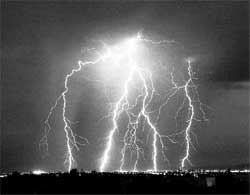Pollution strikes
Pollution strikes

lightning could be primarily responsible for global warming, as it produces a quarter of the planet's concentration of nitrogen oxides (nox), according to a recent study conducted by Colin Price and his team at the Lawrence Livermore National Laboratory in California, us (New Scientist, Vol 153, No 2066).
The high temperature and pressure in the air along the path of a lightning flash causes the breakup of nitrogen and oxygen molecules into fragments that recombine to form nox. More violent lightning generally emits more nox which in turn combines with other gases in the air and generates ozone, which is a major greenhouse gas that contributes to global warming.
Price and his team used satellite images of clouds around the world and data from the us lightning detecting network, and calculated that there are about 70 to 100 lightning flashes every second worldwide. Their studies suggest that lightning is the largest natural source of nox in the atmosphere, producing 10 to 15 million tonnes (mt) of it a year, compared to about 24 mt from burning fossil fuels and eight mt from burning forests, savanna grasslands and fields.
Most lightning occurs over land in summer because intense heating of the land creates strong updrafts that generate thunderstorm clouds. Since most land is in the northern hemisphere, the frequency of lightning flashes is greatest in the northern summer. The findings have even overturned assumptions about the cause of nox pollution in the northern hemisphere. "Until now it has been assumed that the greater amount measured today in the north was due to human activity being concentrated there,' says Price.







